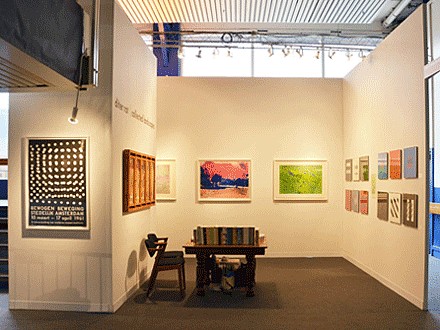dieter roth landscapes features seminal works from 1960-79. Though landscapes constitute a small part of Dieter Roth's approximately 600 graphic works, they are notable for their powerfully perceived subject. Most of these works are appropriated from mass-produced imagery. Roth first began to appropriate such imagery when, in 1961, he cut stacks of British Daily Mirror newspapers into small 2 cm cubes and bound them with cheesecloth to form the daily mirror book. With this gesture Roth created the first conceptual artist's book. Also that year, he combined newspaper pages, now shredded and mixed with gelatin, lard and spices in a sausage casing, creatingLiteraturwurst (Literature Sausage). A unique example of this iconic work is on show as well as another organic piece, the Spice Window from 1971(pictured above) where he used spices to offer an olfactory experience.The earliest examples of Roth's landscapes are altered postcards. In these, the artist takes two like postcards of Icelandic views, cuts them in half horizontally and then tapes two top (or bottom) halves together to form a conceptual symmetric landscape. Five variations of these works, on view, were sent to a dealer in Germany to be sold for 5 Marks each in 1964; however, they were never sold and were kept in the original mailing envelope. Roth's most famous reproduced postcard is of London's Piccadilly Circus, the basis for numerous works, several of which are on display . When Roth began a series of silkscreen monotypes in 1970, rather than a postcard he used a photograph of the square in front of the train station in Solothurn, Switzerland, that became the basis for new work.
Solothurner Bahnhofplatz, 1970, is one of a series of monotype prints made with a revolutionary silkscreen process Roth had developed, employing 10 to 20 colors to create unique images. The idea behind these visually magical prints, and one which encapsulates Dieter's philosophy, is to practice art as life and life as art--each pull and each color results in an unknown outcome, a chance happening or a beautiful accident. A group of these monotype Swiss landscapes, Solothurner Bahnhofplatz, Berner Oberland and View of the Emme are featured in the booth. *There is a special presentation of the hand cut books in refabricated simple aluminum frames Dieter designed for the furniture shop, KULAN in Reykjavik in 1961. These books cross borders of classification as they require the viewer to be involved in the visual output. They were exhibited with Group Zero, Oeuvre d'Art Transformable at Gallery One in London, Galerie Loeb in Paris, Nouvelle Tendencies in Zagreb, Moving Movement in Amsterdam, Museum Haus Lange in Krefeld, and many other venues.
*New publication: diter rot collected landscapes, 2014 is available upon request.
Booth in the Entrance Lounge to Pier 92



